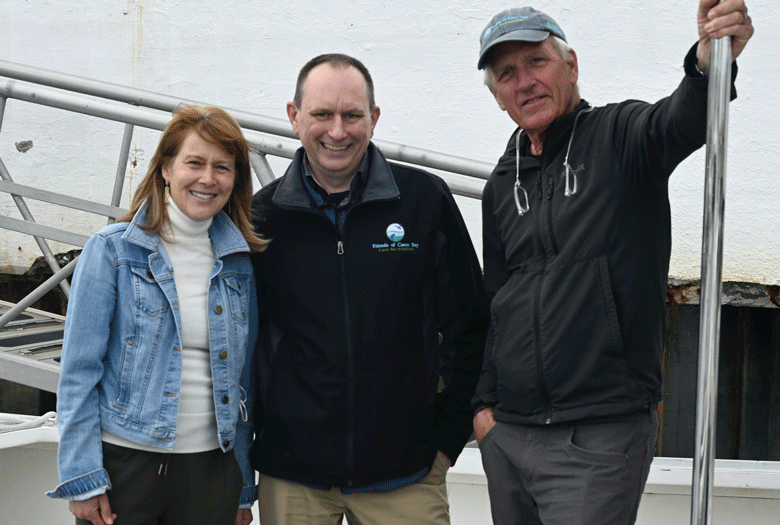After the weather Maine experienced in December and January, even the staunchest climate change skeptic had to admit that something is up.
Three powerful storms—a rainstorm in December and two coastal windstorms in January—roared through the state.
Several factors, other than their arrival in rapid succession, made those winter storms unusual. They brought lots of rain, especially in December, but very little snow. The two January storms brought the highest tides seen along much of the Maine coast since at least the blizzard of 1978.
They wrought uncountable hardship and, in aggregate, millions of dollars in damage to public and private infrastructure primarily as a result of flooding, both inland and in Maine’s many harbors.
The city is installing four underground tanks that will hold millions of gallons of combined stormwater and sewage…
The washed-out roads and bridges around the state were obvious—guests and workers at the Sunday River were reportedly trapped at the ski resort for more than two days before the road was reopened—and photos of flooded businesses, destroyed wharfs, and other damaged coastal infrastructure made national news.
But there was another consequence of the storms that received, perhaps, less immediate attention: the impact of runoff from the torrential rain and receding tide—stormwater—on the state’s coastal ecosystems.
That was the topic of an online “Coffee with the Casco Baykeeper,” Ivy Frignoca, hosted via Zoom by the Friends of Casco Bay in early February. Stormwater runoff and pollution have been long-term concerns of the organization and its Baykeeper, and the network of citizen “water reporters” have been monitoring their effects on the Casco Bay watershed for years. Those effects, positive and negative, are both significant and growing.
Frignoca explained that stormwater is “any form of moisture that falls from the sky” in quantities significant enough to “run off from the land into our waterways.” Stormwater can become polluted both by what’s in the atmosphere—dust, chemicals—and by what it comes into contact with on the ground.
“And that could be, say, cow manure or fertilizers from farm fields. It could be fertilizers and pesticides from lawns. And it is increasingly any kind of pollution that is on our urbanized landscapes, like heavy metals, car exhaust, cigarette butts, pet waste, anything on our built surfaces that collects there and then runs off in the water.”
In winter, additional pollutants come from the salt used to keep roadways, steps and sidewalks free of ice, which ultimately washes into streams and brooks and makes the water too salty and “toxic to aquatic life,” she said.
The greatest problems with runoff into the Casco Bay watershed, though, come from excessive levels of nitrogen pollution. Nitrogen provides critical nourishment for the phytoplankton at the base of the bay’s marine food web. Too much nitrogen, though, can lead to excessive blooms of algae that “can cause serious health problems in the bay,” Frignoca said.
In urban areas, the problem is compounded when runoff is so heavy that it overwhelms the capacity of the combined stormwater and sanitary sewer collection and treatment system so that raw sewage floods into the bay. Near Back Cove in Portland’s Bayside neighborhood, the city is installing four underground tanks that will hold millions of gallons of combined stormwater and sewage—which would otherwise have flowed straight into Back Cove—until it can be treated.
According to Frignoca, the problem is growing. In the past year, she said, Portland alone dumped 373.6 million gallons of combined sewer overflow into Casco Bay, nearly twice the amount that flowed into the bay just five years ago. That increase can be attributed both to heavier and more frequent rain events and increased development resulting in more impervious surfaces—roads, driveways, buildings—that reduce the capacity of the ground to absorb stormwater.
The Department of Environmental Protection has studied five distinct watersheds over a period and looked at the impacts of growing urbanization on stormwater pollution. Perhaps unsurprisingly, the two most threatened were the Fore River watershed and coastal Casco Bay—areas with significant growth over the past few years.
DEP has begun to develop new stormwater management rules for the state that Frignoca hopes will address, and perhaps require the use of “low impact development” methods that can reduce that size of impervious surfaces. The new rules won’t come anytime soon, though.
According to Frignoca, a stakeholders committee and a DEP technical advisory group working on a new rule hope to finish their work by June and the department can then begin the formal rulemaking process. Its proposed rule would go to the Board of Environmental Protection for public hearings and eventual adoption.
The rule would then go to the legislature for further hearings, possible amendment, and approval. The end product of that process would then go back to the Board for adoption. In the meantime, increased stormwater runoff seems likely to have a growing impact on Maine’s waterways.





